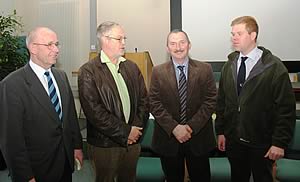|
07/03/07
Suffolk Sheep Society members have been praised for embracing
change. “You’re changing faster than any other sheep
breed, to meet the needs of today’s market.”
(Left to right) Society chairman, Jim Fleming, with speakers David
Croston, former chief of EBLEX; Issac Crilly, NSA NI chairman and
Dr Steven Johnson, Greenmount.
 |
This was the message delivered by Dr Steven Johnson, Senior
Beef and Sheep Technologist, to some 70 members at the Society’s
recent annual meeting, held at his Greenmount Campus base, Northern
Ireland (Tues 28 Feb).
“With the removal of subsidies the main driver for profitable
sheep production is to reduce costs and in particular labour
costs. Carcase quality is no longer the dominant driver it once
was,” says Dr Johnson.
Today’s demands were highlighted by leading commercial
sheep breeder and chairman of the National Sheep Association
(Northern Ireland Region), Issac Crilly. “We need to produce
large numbers of lambs with minimum labour input, ease of management
is absolutely essential on my farm where sheep are our only enterprise,” he
told the Suffolk breeders.
As one of four lowland farms chosen to take part in trials run
by the Agri-Food and Biosciences Institute, Hillsborough (AFBI),
to evaluate the merits of selection for easycare traits in both
the sire and dam, Mr Crilly said his first hand experience had
left him in no doubt as to the enormous potential for using easycare
rams: “Amongst the rams the research team sent was a 50%
New Zealand Suffolk, for traditionalists this ram had no quality – but
results from last year’s crop of lambs totally changed
my mind.”
“There was markedly lower labour input at lambing time
with over 80% of lambs born without any assistance. This halved
the intervention compared to traditional terminal sires. The
lambs from this ram did grow exceedingly well on an all grass
system and all met the target spec required,” acknowledged
Mr Crilly who is achieving 560kg of liveweight per hectare from
his commercial lamb enterprise, where ewes leave a £25
gross margin.
When questioned about carcase quality both Dr Johnson and Mr
Crilly confirmed that the New Zealand Suffolks used in AFBI trials
produced less E and U grade lambs, equivalent in value of output
per ewe of 90p, but emphasised that the benefits of labour reduction
far outweighed this factor.
Independent consultant, and former EBLEX (English Beef and Lamb
Executive) Director, David Croston pointed to changing purchasing
habits and market needs: 85% of lamb is now purchased through
supermarkets. Supermarkets put product on poly-trays of a certain
size and the consumer wants lamb products at a certain price.
The optimum market requirement to meet the supermarket trade
is 19kg R3L.
All speakers agreed that the modern requirement is for longer
and better loins, while the shape of the back leg - the gigot,
is no longer as important as it once was.
Mr Crilly emphasised that the trials were not about promoting
any particular breed, but rather trialling easycare low labour
traits. The rams he had used happened to be easycare Suffolks
and have provided him not only with ease of management, but also
the unrivalled growth for which the breed is renowned.
Robyn Hulme, commercial director said: “I am delighted
that the comments of all three speakers vindicates the policy
that the Suffolk Society Council has adopted, in emphasising
that future commercial requirements will be dominated by ease
of management with low level labour systems. The new free recording
schemes now available to all Suffolk members will enable them
to measure new traits including ease of lambing and lamb vigour,
both of which are vital requirements for low labour input systems.”
 Top Quality Colostrum Added To Shepherdess Range Top Quality Colostrum Added To Shepherdess Range
 24/7 Support Line for Lambing Season 24/7 Support Line for Lambing Season
 Your Chance to Ask Questions on Sheep ID Your Chance to Ask Questions on Sheep ID
|


